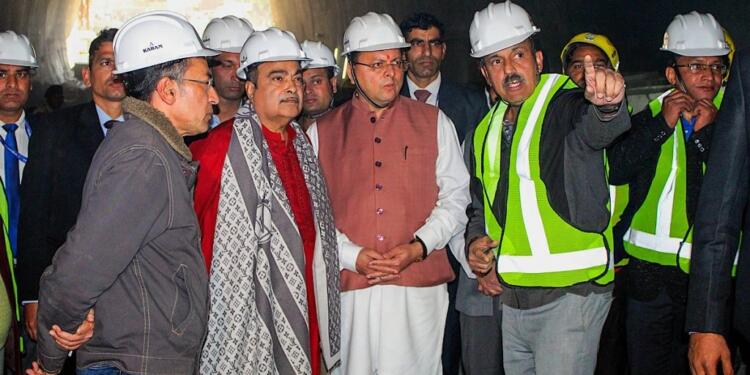In the predawn hours of Sunday, November 12th, a construction tragedy unfolded in northern Uttarakhand, as an under-construction tunnel collapsed, entailing a dire situation for 41 workers. The incident prompted an urgent and intricate rescue operation to extricate those trapped within the debris. Originating from diverse regions such as Bihar, Jharkhand, Uttar Pradesh, West Bengal, Odisha, Uttarakhand, and Himachal Pradesh, the workers found themselves caught in the turmoil of the collapsed Silkyara Tunnel, situated on the Uttarkashi-Yamnotri road.
Amidst the gravity of the situation, the Silkyara Control Room reported on Monday, November 13th, that communication had been established with the trapped individuals through walkie-talkies. The encouraging news emerged that all 41 workers were unharmed. Responding promptly to their needs, a unique solution was devised: food was delivered to the trapped workers through a compression pipe, spanning a distance of approximately 60 meters.
The Silkyara Tunnel, a crucial component of the Char Dham all-weather road project, has become the focal point of attention due to this unfortunate incident. The tunnel, a testament to the infrastructural developments in the region, has been under construction as part of the Rs 12,000-crore highway expansion project in Uttarakhand—an ambitious flagship initiative by the Central government launched in 2016.
The crisis prompted high-profile attention, with Union Road Transport and Highways Minister Nitin Gadkari and Uttarakhand Chief Minister Pushkar Dhami personally overseeing the relief efforts at the Silkyara tunnel on Sunday, November 19th. The urgency of the situation was palpable, as the workers had already been trapped for eight days, necessitating swift and decisive action.
Also Read: Nitin Gadkari – a minister who seldom talks but his work speaks for itself
Nitin Gadkari, after inspecting the site, expressed confidence that the deployment of an advanced drilling machine would expedite the rescue operation, with the assurance that the trapped workers would be reached within the next two days. Emphasizing the paramount importance of saving lives, he stated, “Our priority is to save their lives. Work is on a war footing.”
In a press briefing following his on-site inspection, Gadkari outlined the multi-faceted approach to the rescue operation. A vertical drilling mechanism was underway to physically contact the trapped workers, with the involvement of both government and private agencies. The government is looking at all possible solutions including roping in American experts, as well as, a robotics team to enhance the rescue efforts.
Addressing concerns about the workers’ well-being, Gadkari stressed that authorities were solely focused on their safety.
A six-inch pipe was installed to facilitate the delivery of essential supplies, including food, medicine, water, and oxygen, to the trapped workers. Gadkari acknowledged the initial provision of cashews, pistachios, and nuts through the pipe, and he assured that efforts were underway to diversify the offerings to include more substantial items like roti sabzi.
Gadkari also revealed that a committee had been formed by the Uttarakhand government to investigate the root cause of the incident. He urged against premature conclusions, emphasizing that experts were rigorously analyzing the situation. The involvement of various agencies, including the Geological Survey of India, demonstrated a comprehensive effort to leverage expertise and resources. While expressing the concerns of Prime Minister Narendra Modi, he underscored confidence in the collective efforts, stating, “We will succeed.”
Gadkari, emphasizing the unwavering commitment to the safety of the workers, highlighted the collaborative efforts of the Uttarakhand government and the Government of India. A two-hour-long meeting with concerned officers laid the foundation for a multi-faceted rescue strategy. He assured that six alternate options were under consideration, drawing on the expertise of various government agencies, including the Prime Minister’s Office, tunnel experts, and officials from the Border Roads Organization (BRO).
The Union Minister underscored that the primary focus was on immediate relief for the stranded victims, prioritizing the provision of essential supplies such as food, medicine, and oxygen. Gadkari reiterated, “We are not worried about anything but the only priority is safety (of workers).”
Delving into the detailed rescue plans, Gadkari outlined a six-front strategy aimed at ensuring the safe extraction of the trapped workers:
Plan 1: Involves the insertion of 900mm pipes amidst the debris to create a tunnel-shaped passage. Efforts are underway to fortify the tunnel’s roof, strategically placing cement blocks for team escape routes. Progress so far includes drilling 24 meters with four pipes (900mm) of 6 meters each, supplemented by a life support line of 6-8 inches in diameter.
Plan 2: Entails vertical drilling into the camel-shaped mountaintop, creating a passage behind the debris. This not only facilitates the extraction of trapped workers but also holds potential as a supply line if the passage’s width allows.
Plans 3 and 4: Involve horizontal drilling from the right and left sides of the tunnel, respectively, with the aim of establishing escape routes opening behind the debris.
Plan 5: Accelerates tunnel excavation from the Polgoun entrance, focusing on the remaining 450-meter section between Silkyara and Polgoun ends.
Plan 6: Focuses on establishing a supply line amid debris and rocks from the tunnel roof cavity.
These detailed strategies reflect the exhaustive efforts and meticulous planning underway to overcome the challenges presented by the collapsed tunnel, providing a glimpse into the complexity of the rescue operation and the dedication to securing the well-being of those affected.
As the rescue mission for the 41 trapped laborers in the under-construction tunnel of northern Uttarakhand enters its second week, a wide range of efforts unfold, blending innovation, coordination, and challenges inherent in the Himalayan terrain.
>>>Click the link to Join Our WhatsApp Channel<<<
In the initial stages, micro-drone cameras played a pivotal role, meticulously scanning the collapsed tunnel for openings. This strategic exploration paved the way for the insertion of a crucial supply line from the hilltop, a lifeline that delivered not only essential supplies but also hope to those trapped below.
The rescue efforts have been a collaborative endeavor, with multiple agencies such as the National Disaster Response Force (NDRF), State Disaster Response Force (SDRF), Border Roads Organisation (BRO), National Highways and Infrastructure Development Corporation Limited (NHIDCL), and Indo-Tibetan Border Police (ITBP) joining forces. Their collective determination is a testament to the unwavering commitment to bringing the trapped workers to safGadkariety.
Addressing the unique challenges posed by the Himalayan terrain, Union Minister Nitin Gadkari highlighted the fragility of the region, contrasting it with the solid stones of the Deccan. This insight underscores the complexities faced by rescue teams operating in this geographically demanding environment.
Amidst the rescue operations, a poignant moment unfolded when Arun Kumar Mishra, an official from Uttar Pradesh, communicated with the trapped workers using a hume pipe. The muffled voices from the depths of the tunnel pleaded for a swift rescue, detailing the challenging conditions they faced despite the provision of food and water.
As the ordeal continues, the dedication of rescue teams remains unwavering.
Support TFI:
Support us to strengthen the ‘Right’ ideology of cultural nationalism by purchasing the best quality garments from TFI-STORE.COM

































